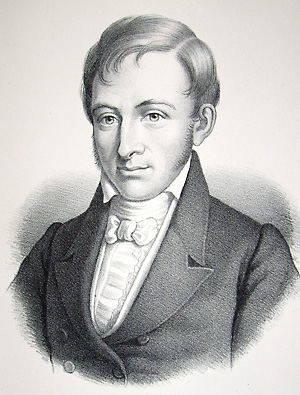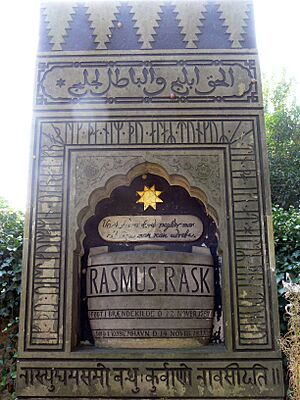Rasmus Rask facts for kids
Quick facts for kids
Rasmus Rask
|
|
|---|---|
 |
|
| Born |
Rasmus Christian Nielsen Rasch
22 November 1787 Brændekilde, Denmark
|
| Died | 14 November 1832 (aged 44) Copenhagen, Denmark
|
| Alma mater | University of Copenhagen |
Rasmus Kristian Rask (Danish: [ˈʁɑsmus ˈkʰʁestjæn ˈʁɑsk]; born Rasmus Christian Nielsen Rasch; 22 November 1787 – 14 November 1832) was a Danish linguist and philologist. A linguist studies how languages work, and a philologist studies languages in old texts.
Rask wrote many grammar books and studied how language sounds (phonology) and how words are formed (morphology). He traveled a lot to learn about different languages. He went to Iceland, Russia, Persia, India, and Ceylon. He even wrote the first grammar book for the Icelandic language.
Before he passed away, he became a professor of Eastern languages at the University of Copenhagen. Rask is famous for his work in comparative linguistics. This is the study of how languages are related to each other. He helped create an early idea of what is now called Grimm's Law. This law explains how certain sounds changed over time in different languages. In 1829, he became a member of the American Philosophical Society.
Contents
A Young Language Genius
Rasmus Rask was born in a small village called Brændekilde, near Odense, in Denmark. His father was a farmer and tailor who loved to read. He had a good collection of books.
From a young age, Rasmus showed he was very smart. When he was 13, in 1801, he went to the Latin school in Odense. One of his friends from school, Niels Matthias Petersen, later said that Rasmus was easy to spot. He was short, had lively eyes, and moved quickly. He also had amazing knowledge and wore simple clothes from the countryside.
At this school, Rasmus became very interested in Old Norse and Icelandic language. His teacher lent him a book called Heimskringla in Icelandic. The school principal gave him a new translation of the same book as a prize. By comparing the original Icelandic book with its translation, Rasmus created his own Icelandic vocabulary list. He linked Icelandic words to similar words in Danish, Swedish, German, Dutch, and English.
Besides Danish and Latin, Rasmus also studied Greek, Hebrew, French, and German. He was also very interested in spelling. He even created his own spelling system for Danish. It was designed to match how Danish was spoken. This is when he changed his last name from "Rasch" to "Rask."
University Studies
In 1808, Rask moved to Copenhagen to study at the University of Copenhagen. He lived in a student dorm called Regensen. Even though he wasn't very religious, he signed up to study theology. But in reality, he spent his time studying the grammar of many different languages.
By 1812, he had carefully studied languages like Sami, Swedish, Faroese, English, Dutch, Gothic, Old English, and Portuguese. He also started learning German, French, Spanish, Italian, Greek, Latin, Russian, Polish, and Czech. But Icelandic remained his favorite language to study.
In 1809, he finished his first book, Introduction to the Icelandic or Old Norse Language. It was published in Danish in 1811. This book was a teaching guide based on earlier works. Experts say it was better than anything published on the topic before.
Winning a Prize
In 1811, the Royal Danish Academy of Sciences and Letters offered a prize for an essay. The essay needed to explain where the old Scandinavian language came from. It also had to describe its features and how it related to other Nordic and Germanic languages.
To research for this essay, Rask traveled to Sweden in 1812 with his friend Rasmus Nyerup. There, he studied Sami and Finnish. He wanted to see if they were related to the Scandinavian languages. When he returned to Denmark, he was recommended to the Arnamagnæan Institute. They hired him to help edit an old Icelandic dictionary.
From 1813 to 1815, Rask visited Iceland. He became very good at speaking Icelandic and learned a lot about Icelandic literature and customs.
In 1814, while still in Iceland, he finished his prize essay. It was called "Investigation of the Origin of the Old Norse or Icelandic Language" and was published in 1818. In this essay, he argued that Old Norse was related to the Germanic languages (like Gothic). He also said it was related to Baltic and Slavic languages, and even to old Latin and Greek. He was wrong about some languages, like Celtic languages, but he later admitted his mistake.
The Academy accepted his essay. They suggested he compare Icelandic with Persian and other Asian languages. This made Rask dream of a trip to India to study languages like Sanskrit. In 1814, after returning from Iceland, Rask worked as a sub-librarian at the University of Copenhagen library.
Travels to Asia
In October 1816, Rask left Denmark for a long trip. The king paid for him to explore Asian languages and collect old books for the University of Copenhagen library. He first went to Sweden and stayed for two years. While there, he took a short trip to Finland to study Finnish. He also published his Anglo-Saxon Grammar (1817) in Swedish.
In the same year, he published the first complete versions of Snorri Sturluson's Prose Edda and Sæmundr fróði's Poetic Edda. These books were bilingual, with the original Icelandic text and his Swedish translations. In 1819, he left Stockholm for St. Petersburg, Russia. There, he wrote a paper about the languages and literature of Norway, Iceland, Sweden, and Finland.
Leaving Russia, he traveled through Central Asia to Persia. He visited cities like Tabriz, Tehran, Persepolis, and Shiraz. It is said that in about six weeks, he learned enough Persian to speak freely.
In 1820, he traveled from Bushehr, Persia, to Mumbai, India. While living there, he wrote a paper in English about the Zend language. From Mumbai, he traveled through India to Sri Lanka (then called Ceylon), arriving in 1822. Soon after, he wrote another paper in English. This one was about the best way to write Indian sounds using European letters.
Back in Denmark

Rask returned to Copenhagen in May 1823. He brought many old books and writings in Persian, Zend, Pali, and Sinhala for the Copenhagen libraries. In 1825, he became a professor of literary history. In 1829, he also became a librarian at the University of Copenhagen. In 1831, just a year before he died, he was made a professor of Eastern languages at the university.
After returning home, Rask published several more books. These included Spanish Grammar (1824), Frisian Grammar (1825), and Essay on Danish Orthography (1826). He also wrote about ancient Egyptian and Jewish history. He published A Grammar of the Danish Language for the use of Englishmen (1830). He also helped with the English translation of his A Grammar of the Anglo-Saxon Tongue (1830).
His Death
Rasmus Rask died from tuberculosis in Copenhagen in 1832. He is buried in Assistens Cemetery. He left his old writings to his brother. His brother then sold the Old Norse-Icelandic materials to the Arnamagnæan Commission in Copenhagen, where they are still kept today.
What He Achieved
Rask was the first to show how the ancient Northern Germanic languages were related to the Western and Eastern Germanic languages. He also showed their connection to Lithuanian, Slavonic, Greek, and Latin.
He created the first working idea of what would later be called "Grimm's Law." This law explains how certain consonant sounds changed when old Indo-European languages developed into Germanic languages. At the time, he only compared Germanic and Greek, as he didn't know about Sanskrit yet.
By 1822, Rask knew 25 languages and dialects. It is believed he studied twice that many! His many writings about languages were given to the Royal Danish Library in Copenhagen. Rask's grammar books for Anglo-Saxon, Danish, and Icelandic were later published in English. Rask influenced many linguists who came after him.
See also
 In Spanish: Rasmus Christian Rask para niños
In Spanish: Rasmus Christian Rask para niños

